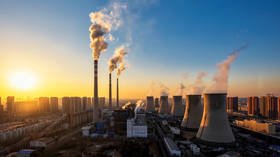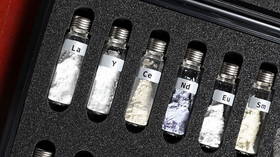US is losing the energy tech war against China

A new report from Bank of America has revealed that China vastly outspent the US in renewable energy technology while becoming a monopolist in much-needed rare-earth materials that are often required to build clean energy systems.
For years, the US and China have waged war over technology, trade, and capital markets. Tensions between the world’s leading economies reached a fever pitch during former president Trump’s term in office, leading to escalating tariffs and trade restrictions.
But now, a new revelation will have Washington scratching its head again: China has been vastly outspending the United States in renewable energy R&D.
Also on rt.com China is the biggest winner of the US renewables boomAccording to BNEF data cited by Bank of America in a recent report, for every dollar that the US spent on renewable energy research between 2010 and 2020, China spent two, making it by far the leading investor in renewable energy around the world.
BofA says in this new climate war, China hopes to gain the upper hand in supply chain dominance, carbon-related trade tariffs, and domestic-focused manufacturing policies.
Global supremacy
According to BofA, it’s not just the need to mitigate the effect of climate change. The biggest motivating factor in fact, is quite different: Attaining energy independence and global supremacy.
“It’s not just about saving the planet. We believe climate strategies offer a route to global supremacy, as much more is at stake here: the economic impact of climate could reach $69 trillion this century, and energy transition investment needing to rise up to $4 trillion per year. Energy independence and supply chain control are also at stake with the geopolitical balance of power also linked to peak oil in 2030.”
According to Harry Broadman, managing director and chair of the emerging markets and CFIUS practices at Berkeley Research Group, “We’ve done really well among democratic countries collaborating on investment and trade, but we’ve done an extraordinarily poor job in R&D, and this is where China is frankly a huge competitive and potentially a huge economic and maybe geopolitical, threat,” he said.
Energy independence
Since the days of President Jimmy Carter and the 1970s oil crisis, the United States has relentlessly pursued the utopia of energy independence. But persistent oil crises, severe oil price shocks, and the global shift to clean energy have made it glaringly obvious that Washington will never achieve true energy independence by relying solely on fossil fuels.
Indeed, the majority of Americans believe that the government should “...focus on developing alternative sources of energy over expansion of fossil fuel sources” in a bid to alleviate climate change.
But as the shift to clean and renewable energy gains serious momentum, the United States is now facing another conundrum: It’s almost completely dependent on China for the minerals it uses to build clean energy systems.
Also on rt.com Full decoupling from China could wipe out hundreds of billions from economy – US Chamber of CommerceChina is a rare earth monopoly, supplying 80% of the rare earths elements (REE) used by the United States to manufacture solar panels, windmills, electric car batteries, cellphones, computers, national defense systems, medical equipment, and even in oil and gas technologies.
That leaves the country in a particularly precarious position, especially with the never-ending trade tensions between the two nations. Indeed, all it took was a simple visit to an obscure factory by Chinese President Xi at the height of the trade war last year to raise the specter of Beijing cutting off supplies of critical materials to the US and potentially crippling large swathes of industries.
Further, the US is about to start keenly feeling China’s stranglehold on the industry thanks to Biden’s Green Deal.
Depending on China
Rare earth minerals, also known as the “vitamins of chemistry,” are a group of elements used in the manufacture of a wide range of equipment in small doses to produce powerful salutary effects. These minerals are extensively used in smartphones, batteries, turbines, lasers, electromagnetic guns, missiles, advanced weapon sensors, stealth technology, and jamming technology. For instance, lanthanum is used in lighting equipment and camera lenses; neodymium in hybrid vehicles; praseodymium in aircraft engines; europium in nuclear reactors and gadolinium in MRIs and X-rays. Oil refiners also use rare earth catalysts to process crude oil into gasoline and jet fuel.
China produced more than 90%of the world’s supply of these critical elements over the past decade, though its share fell to 71.4% last year.
In 2018, the US Geological Survey identified 35 minerals critical to the country’s economy and national security. America is heavily dependent on imports of these minerals, producing less than a tenth of the world’s supplies and importing half what it consumes. It clearly highlights the United States’ soft underbelly.
And China’s dominance might only increase going forward.
The global REE industry is expected to nearly double from $8.1 billion in 2018 to $14.4 billion in 2025, as demand for EVs, cell phones, and microchips skyrockets. Biden anticipates this wild growth and has pledged to install 500,000 new EV charging stations by 2030 from the current US tally of 26,000.
Beating China at its own game
But China’s control of REE might not necessarily be ‘‘an ace in Beijing’s hand’’ as the Global Times once claimed. On the contrary, the US is actually in a strong position to dent China’s control of the industry and move towards rare earth independence.
Biden clearly recognizes this challenge and opportunity and has pledged to support the increased exploration of lithium, copper, nickel, and rare earths, among other minerals, to ensure domestic sourcing of minerals critical to solar panels, wind turbines, and electric vehicles.
Indeed, the government of the United States has been ramping up efforts to expand domestic mineral research and development.
Also on rt.com China may exercise ‘nuclear option’ against US defense industry with rare-earths export ban – reportsFor example, the bipartisan Reclaiming American Rare Earths (RARE) Act that was introduced in the House in September offers a comprehensive framework of tax incentives to encourage more investment into the US-based REE mining and production. Meanwhile, dozens of companies and startups from Alaska to Texas are advancing mining development, with a site in Colorado about to become the first non-China facility for refining rare earth ores.
The US is not exactly lacking in REE resources, either. For instance, a mountain in Wyoming called Bear Lodge holds about 18 million tons of REE, enough to supply the country for years.
And if push comes to shove and Beijing suddenly bans REE exports to the United States, America might counter by building a new supply chain outside of China just like Japan did when a similar fate befell the country a decade ago.
Or we can simply start recycling more.
Currently, only around 1% of REE are recycled from end-products at the end of their life cycles.
Yet, the potential of recycling rare earths is huge.
A 2013 paper says that simply boosting the collection rate of batteries, bulbs, and magnets could improve the recycling rate of REE from one percent up to 20-40%. That would amount to up to 5% of global REE mine production, or nearly half of the US annual mine supply. But we could do even better. As Simon Jowitt, assistant professor at UNLV’s Department of Geoscience, has told ArsTechnica, much more than 40% of REE could be recycled depending on adoption rates of technologies like EVs.
To be fair, recycling that amount of rare earths would not be a walk in the park.
The diverse types of electronics being recycled would not necessarily contain enough rare earths and in the right proportions to make recycling those elements profitable. In many cases, the manufacturers usually are not responsible for running recycling operations, meaning they might not even be privy to which components contain what materials.
Here, the United States’ REE industry needs to borrow a leaf from Europe.
The EU’s Waste of Electrical and Electronic Equipment WEEE requires manufacturers of electronic devices to not only finance or perform the recycling of those devices but also requires sellers to offer free e-waste collection.
But ultimately, it might all boil down to political will – or lack thereof.
The permitting process in the US is ridiculously long and can take up to three decades compared to just two years in countries like Australia and Canada. Navigating a regulatory minefield of labyrinthine, local, state, and federal rules stifle US mining companies compared to their Chinese competitors.
But given recent bipartisan moves in the industry, legislators can hopefully look beyond party lines and affiliations and fashion a workaround.
This article was originally published on Oilprice.com

















